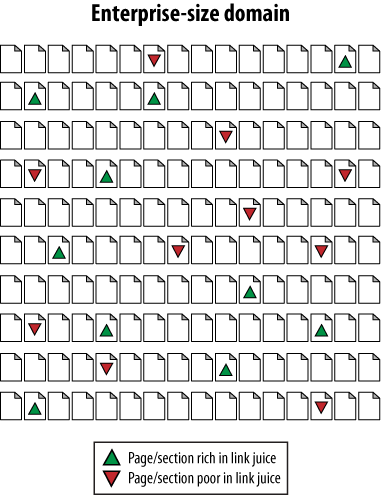4. Example: Fixing an Internal Linking Problem
Enterprise sites range between 10,000 and 10 million pages in
size. For many of these types of sites, an inaccurate distribution of
internal link juice is a significant problem. Figure 3 shows how this can
happen.

Figure 3 is an
illustration of the link juice distribution issue. Imagine that each of
the tiny pages represents between 5,000 and 100,000 pages in an
enterprise site. Some areas, such as blogs, articles, tools, popular
news stories, and so on, might be receiving more than their fair share
of internal link attention. Other areas—often business-centric and
sales-centric content—tend to fall
by the wayside. How do you fix it? Take a look at Figure 4.

The solution is simple, at least in principle. Have the link-rich
pages spread the wealth to their link-bereft brethren. As easy as this
looks, in execution it can be incredibly complex. Inside the
architecture of a site with several hundred thousand or a million pages,
it can be nearly impossible to identify link-rich and link-poor pages,
never mind adding code that helps to distribute link juice
equitably.
The answer, sadly, is labor-intensive from a programming
standpoint. Enterprise site owners need to develop systems to track
inbound links and/or rankings and build bridges (or, to be more
consistent with Figure 4, spouts) that
funnel juice between the link-rich and link-poor.
An alternative is simply to build a very flat site architecture
that relies on relevance or semantic analysis (several
enterprise-focused site search and architecture firms offer these). This
strategy is more in line with the search engines’ guidelines (though
slightly less perfect) and is certainly far less labor-intensive.
Interestingly, the rise of massive weight given to domain
authority over the past two to three years appears to be an attempt by
the search engines to overrule potentially poor internal link structures
(as designing websites for PageRank flow really doesn’t serve users
particularly well), and to reward sites that have massive authority,
inbound links, and trust.
5. Server and Hosting Issues
Thankfully, few server or web hosting dilemmas affect the practice
of search engine optimization. However, when overlooked, they can spiral
into massive problems, and so are worthy of review. The following are
server and hosting issues that can negatively impact search engine
rankings:
Server timeouts
If a search engine makes a page request that isn’t served
within the bot’s time limit (or that produces a server timeout
response), your pages may not make it into the index at all, and
will almost certainly rank very poorly (as no indexable text
content has been found).
Slow response times
Although this is not as damaging as server timeouts, it
still presents a potential issue. Not only will crawlers be less
likely to wait for your pages to load, but surfers and potential
linkers may choose to visit and link to other resources because
accessing your site becomes a problem.
Shared IP addresses
Lisa Barone wrote an
excellent post on the topic of shared IP addresses back in
March 2007. Basic concerns include speed, the potential for having
spammy or untrusted neighbors sharing your IP address, and
potential concerns about receiving the full benefit of links to
your IP address (discussed in more detail at http://www.seroundtable.com/archives/002358.html).
Blocked IP addresses
As search engines crawl the Web, they frequently find entire
blocks of IP addresses filled with nothing but egregious web spam.
Rather than blocking each individual site, engines do occasionally
take the added measure of blocking an IP address or even an IP
range. If you’re concerned, search for your IP address at Bing
using the IP:address query.
Bot detection and handling
Some sys admins will go a bit overboard with protection and
restrict access to files to any single visitor making more than a
certain number of requests in a given time frame. This can be
disastrous for search engine traffic, as it will constantly limit
the spiders’ crawling ability.
Bandwidth and transfer limitations
Many servers have set limitations on the amount of traffic
that can run through to the site. This can be potentially
disastrous when content on your site becomes very popular and your
host shuts off access. Not only are potential linkers prevented
from seeing (and thus linking to) your work, but search engines
are also cut off from spidering.
Server geography
This isn’t necessarily a problem, but it is good to be aware
that search engines do use the location of the web server when
determining where a site’s content is relevant from a local search
perspective. Since local search is a major part of many sites’
campaigns and it is estimated that close to 40% of all queries
have some local search intent, it is very wise to host in the
country (it is not necessary to get more granular) where your
content is most relevant.